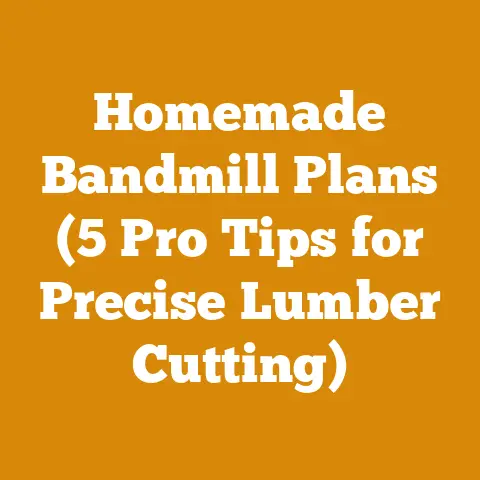Attached Gable Roof Patio Cover (5 Pro Wood Joinery Tips)
And what better way to extend your living space and enjoy the outdoors year-round than with an attached gable roof patio cover?
Not only does it provide shelter from the elements, but it also adds architectural interest and value to your home.
But building one that’s structurally sound and aesthetically pleasing requires more than just nailing some boards together.
It requires understanding and implementing proper wood joinery techniques.
I’ve spent years felling trees, milling lumber, and constructing everything from simple sheds to complex timber frames.
Let me share with you five essential pro wood joinery tips that will elevate your attached gable roof patio cover from a DIY project to a masterpiece.
Attached Gable Roof Patio Cover: 5 Pro Wood Joinery Tips
Understanding the Basics: Why Wood Joinery Matters
Before diving into the specific techniques, let’s talk about why wood joinery is so crucial.
Traditional methods like using nails and screws have their place, but they often rely on the fasteners for strength.
Wood joinery, on the other hand, creates a connection where the wood itself interlocks, distributing stress and creating a much stronger and more durable bond.
This is especially important for a structure like a patio cover, which will be exposed to wind, rain, snow, and the relentless sun.
Proper joinery ensures the structure remains stable and safe for years to come.
Think of it like this: a nailed joint is like a handshake – quick and easy, but not very strong.
A well-executed mortise and tenon joint, however, is like a wrestler’s grip – solid, dependable, and built to last.
I’ve seen countless patio covers fail prematurely due to inadequate joinery.
Don’t let yours be one of them!
Tip #1: The Mighty Mortise and Tenon
The mortise and tenon joint is the king of wood joinery.
It involves cutting a rectangular hole (the mortise) in one piece of wood and shaping the end of another piece to fit snugly inside (the tenon).
This creates a mechanical interlock that’s incredibly strong, especially when combined with glue.
- Applications: This joint is ideal for connecting posts to beams, rafters to beams, and creating sturdy frame corners.
- Tools: You’ll need a mortise chisel, a tenon saw (or a table saw with a tenoning jig), a marking gauge, and a sharp knife.
- Measurements: The tenon should be about 1/3 of the thickness of the wood.
For example, if you’re using 4×4 posts (3.5″ actual dimension), the tenon should be about 1 1/8″ thick.
The mortise should be slightly wider and deeper than the tenon to allow for glue and expansion. - My Experience: I once built a timber frame barn using almost exclusively mortise and tenon joints.
It took longer than using metal fasteners, but the resulting structure was incredibly strong and has withstood hurricane-force winds without a single creak.
Creating a Strong Mortise and Tenon Joint:
- Marking: Accurately mark the location and dimensions of both the mortise and the tenon.
Precision is key! - Cutting the Mortise: I prefer using a mortise chisel and mallet for a clean, controlled cut.
You can also use a drill press with a mortising attachment. - Cutting the Tenon: Use a tenon saw or a table saw with a tenoning jig to create a precise tenon.
Ensure the shoulders of the tenon are square and clean. - Dry Fit: Before applying glue, dry-fit the joint to ensure a snug fit.
Make any necessary adjustments. - Gluing: Apply a high-quality exterior wood glue to both the mortise and the tenon.
- Clamping: Clamp the joint tightly until the glue is fully cured.
Takeaway: The mortise and tenon joint is a foundational skill.
Practice on scrap wood before tackling your patio cover.
Mastering this joint will dramatically improve the strength and longevity of your structure.
Tip #2: The Versatile Lap Joint
A lap joint is created by overlapping two pieces of wood and joining them together.
It’s simpler to execute than a mortise and tenon but still provides a good level of strength.
- Applications: Ideal for connecting beams to posts, creating strong corners, and joining rafters.
- Tools: You’ll need a saw (circular saw, hand saw, or table saw), a chisel, and a marking gauge.
- Measurements: The depth of the lap should be half the thickness of the wood.
For example, if you’re using 2×6 lumber (1.5″ actual thickness), the lap should be 3/4″ deep.
The overlap should be at least the width of the wood.
Creating a Solid Lap Joint:
- Marking: Use a marking gauge to accurately mark the area to be removed on both pieces of wood.
- Cutting: Use a saw to cut along the marked lines.
A circular saw is efficient for long cuts, while a hand saw provides more control. - Chiseling: Use a chisel to remove the waste wood, creating a flat, even surface.
- Dry Fit: As with the mortise and tenon, dry-fit the joint to ensure a proper fit.
- Gluing and Fastening: Apply glue to the mating surfaces and secure the joint with screws or bolts.
Ensure the fasteners are long enough to penetrate deeply into both pieces of wood.
My Personal Touch: I often use a rabbet plane to refine the surfaces of my lap joints.
It creates an incredibly smooth and precise fit, which significantly improves the joint’s strength and appearance.
Takeaway: Lap joints are a great option when you need a strong connection but don’t have the time or tools for more complex joinery.
Just remember to use plenty of glue and appropriate fasteners.
Tip #3: The Strong Scarf Joint
When you need to join two pieces of wood end-to-end to create a longer beam or rafter, a scarf joint is the answer.
Unlike a simple butt joint, which is weak and prone to failure, a scarf joint creates a gradual transition that distributes stress more evenly.
- Applications: Extending beams, rafters, and other structural members.
- Tools: You’ll need a saw (hand saw, circular saw, or table saw), a chisel, and a marking gauge.
A bevel gauge can be helpful for setting the angle. - Measurements: The scarf angle should be between 1:6 and 1:8.
This means that for every inch of thickness, the scarf should extend 6 to 8 inches along the length of the wood.
Creating a Reliable Scarf Joint:
- Marking: Accurately mark the scarf angle on both pieces of wood using a bevel gauge and a marking gauge.
- Cutting: Use a saw to cut along the marked lines.
A table saw with a miter gauge is ideal for creating precise scarf cuts. - Chiseling (Optional): For added strength, you can create a “nib” on one side of the joint and a corresponding recess on the other.
This helps to lock the two pieces together. - Dry Fit: Ensure the two pieces fit together snugly.
- Gluing and Fastening: Apply glue to the mating surfaces and clamp the joint tightly.
Use screws or bolts to further secure the joint.
Stagger the fasteners to avoid weakening the wood.
Case Study: I once had to extend a 20-foot beam for a client’s patio cover.
Instead of buying a single 40-foot beam (which would have been expensive and difficult to transport), I used a scarf joint to connect two 20-foot beams.
The resulting joint was incredibly strong and virtually invisible.
Takeaway: Don’t underestimate the power of a well-executed scarf joint.
It can save you money and make seemingly impossible projects possible.
Tip #4: The Hidden Spline Joint
A spline joint is a hidden reinforcement that adds strength and stability to butt joints.
It involves cutting a groove in both pieces of wood and inserting a thin strip of wood (the spline) into the groove.
- Applications: Strengthening butt joints in trim, fascia, and other non-structural elements.
- Tools: You’ll need a router with a slot cutting bit, a table saw, and a marking gauge.
- Measurements: The spline should be about 1/3 of the thickness of the wood.
The groove should be slightly wider and deeper than the spline to allow for glue.
Constructing a Seamless Spline Joint:
- Cutting the Grooves: Use a router with a slot cutting bit to create a groove in both pieces of wood.
Ensure the grooves are aligned perfectly. - Making the Spline: Cut a strip of wood to fit snugly into the grooves.
The spline should be made from a strong, stable wood like hardwood. - Dry Fit: Test the fit of the spline in the grooves.
- Gluing: Apply glue to the grooves and the spline.
- Clamping: Clamp the joint tightly until the glue is fully cured.
My Secret Weapon: I often use a biscuit joiner to create spline joints.
Biscuit joiners are quick, accurate, and create a strong, reliable joint.
Takeaway: Spline joints are a simple and effective way to add strength and stability to your patio cover’s non-structural elements.
They also create a clean, professional look.
Tip #5: The Art of Weatherproofing: Sealing and Protecting Your Joints
No matter how strong your wood joinery is, it won’t last long if it’s exposed to the elements without proper protection.
Weatherproofing is essential for extending the life of your patio cover.
- Applications: All joints, especially those exposed to rain, snow, and sun.
- Materials: You’ll need a high-quality exterior wood glue, a wood preservative, and a sealant.
Techniques:
- Gluing: Use a waterproof exterior wood glue for all joints.
- Wood Preservative: Apply a wood preservative to all exposed wood surfaces, especially the end grain.
This will help to prevent rot and insect infestation. - Sealing: Apply a sealant to all joints and cracks to prevent water from penetrating the wood.
Use a flexible sealant that can accommodate wood movement. - Painting or Staining: Apply a coat of exterior paint or stain to protect the wood from the sun’s UV rays.
Choose a high-quality product that is designed for outdoor use.
My Weatherproofing Ritual: Before assembling any outdoor structure, I always soak all the wood in a copper-based wood preservative.
It’s an extra step, but it significantly extends the life of the wood.
Common Mistakes to Avoid:
- Using Interior Glue: Interior glue is not designed for outdoor use and will fail quickly.
- Skipping the Wood Preservative: This is a critical step in preventing rot and insect infestation.
- Using Cheap Sealant: Cheap sealant will crack and peel, allowing water to penetrate the wood.
- Neglecting Maintenance: Regularly inspect your patio cover for signs of damage and make repairs as needed.
Takeaway: Weatherproofing is just as important as wood joinery.
By taking the time to properly seal and protect your joints, you can ensure that your patio cover will last for many years to come.
Choosing the Right Wood for Your Patio Cover
Selecting the right wood species is paramount for the longevity and aesthetics of your attached gable roof patio cover.
Each wood type offers distinct characteristics in terms of durability, resistance to decay, workability, and cost.
Here’s a breakdown of popular choices and my recommendations:
1. Pressure-Treated Lumber:
- Pros: Highly resistant to rot, decay, and insect infestation. Cost-effective and readily available.
- Cons: Can contain chemicals, may require special disposal methods, and can sometimes warp or twist.
- Best For: Posts, beams, and any components in direct contact with the ground or exposed to constant moisture.
- My Insight: While pressure-treated lumber is a practical choice for structural elements, I often recommend wrapping it with cedar or redwood for a more aesthetically pleasing finish.
2. Cedar (Western Red Cedar):
- Pros: Naturally resistant to rot, decay, and insects.
Lightweight, easy to work with, and has a beautiful reddish-brown color and aromatic scent. - Cons: More expensive than pressure-treated lumber, can be prone to denting.
- Best For: Rafters, decking, trim, and decorative elements.
- My Experience: I’ve built numerous patio covers with cedar, and its natural beauty and durability make it a top choice for exposed elements.
It also takes stain and paint very well.
3. Redwood:
- Pros: Similar to cedar in terms of rot and insect resistance.
Rich, reddish-brown color and a beautiful grain pattern. - Cons: More expensive than cedar, can be difficult to source in some regions.
- Best For: Rafters, decking, trim, and decorative elements.
- Note: Redwood is more resistant to moisture-related expansion and contraction compared to cedar.
4. Douglas Fir:
- Pros: Strong, stiff, and relatively inexpensive. Readily available and easy to work with.
- Cons: Not as naturally resistant to rot and decay as cedar or redwood.
Requires thorough sealing and protection. - Best For: Framing, rafters, and posts (when properly treated).
- Caution: Douglas Fir should only be used in dry climates unless it is pressure-treated or meticulously sealed.
5. Hardwoods (Oak, Maple, Teak):
- Pros: Extremely durable, strong, and resistant to wear and tear.
- Cons: Very expensive, difficult to work with, and requires specialized tools.
- Best For: High-end patio covers, decorative elements, and projects where durability is paramount.
- Recommendation: While hardwoods offer exceptional durability, their cost and workability often make them less practical for typical patio cover construction.
Wood Selection Checklist:
- Climate: Consider your local climate and choose wood species that are well-suited to the conditions.
- Budget: Set a budget and choose wood species that fit within your price range.
- Aesthetics: Select wood species that match your desired aesthetic.
- Durability: Choose wood species that are durable and resistant to rot, decay, and insects.
- Workability: Select wood species that are easy to work with, especially if you’re a beginner.
- Sustainability: Consider using sustainably harvested wood.
My Top Recommendation: For a balance of durability, affordability, and aesthetics, I recommend using pressure-treated lumber for the posts and beams, and cedar for the rafters, decking, and trim.
This combination provides a strong, long-lasting, and beautiful patio cover.
Measuring and Marking Tools:
- Tape Measure (25 feet): For accurate measurements of lumber and overall dimensions.
- Speed Square: For marking square cuts and angles.
- Combination Square: For precise measurements and marking depths.
- Level (4 feet): For ensuring posts, beams, and rafters are level.
- Laser Level: For accurate leveling over long distances.
- Chalk Line: For marking straight lines over long distances.
- Marking Gauge: For marking consistent lines parallel to an edge.
- Bevel Gauge: For setting and transferring angles.
Cutting Tools:
- Circular Saw: For making straight cuts in lumber.
- Miter Saw: For precise angle cuts in lumber.
- Table Saw: For ripping lumber and making dadoes and rabbets.
- Hand Saw: For detail work and making cuts in tight spaces.
- Jigsaw: For cutting curves and irregular shapes.
- Reciprocating Saw: For demolition and rough cutting.
Drilling and Fastening Tools:
- Drill/Driver: For drilling holes and driving screws.
- Impact Driver: For driving screws quickly and efficiently.
- Cordless Drill: For drilling holes and driving screws without a power outlet.
- Hammer Drill: For drilling holes in concrete and masonry.
- Nail Gun: For quickly and efficiently driving nails.
- Wrench Set: For tightening bolts and nuts.
- Socket Set: For tightening bolts and nuts in hard-to-reach places.
Wood Joinery Tools:
- Mortise Chisel Set: For cutting mortises.
- Tenon Saw: For cutting tenons.
- Router: For creating grooves, rabbets, and decorative edges.
- Biscuit Joiner: For creating spline joints.
- Clamps (Various Sizes): For holding wood pieces together while gluing.
Safety Gear:
- Safety Glasses: To protect your eyes from flying debris.
- Hearing Protection: To protect your ears from loud noises.
- Work Gloves: To protect your hands from splinters and cuts.
- Dust Mask: To protect your lungs from sawdust.
- Respirator: For protection when working with chemicals or sanding.
- Steel-Toed Boots: To protect your feet from falling objects.
Other Essential Tools:
- Ladder: For reaching high places.
- Wheelbarrow: For moving materials.
- Shovels and Rakes: For site preparation and cleanup.
- Utility Knife: For general cutting and trimming.
- Pencils and Markers: For marking measurements and cut lines.
- First Aid Kit: For treating minor injuries.
Tool Maintenance Tips:
- Keep your tools clean and sharp.
- Store your tools in a dry place.
- Lubricate your tools regularly.
- Replace worn or damaged parts.
- Follow the manufacturer’s instructions for proper use and maintenance.
My Tool Philosophy: I believe in investing in high-quality tools that will last for years.
While they may cost more upfront, they will save you time, frustration, and money in the long run.
Phase 1: Planning and Preparation
-
Design and Permitting:
- Sketch your desired patio cover design, including dimensions, roof pitch, and support structure.
- Check local building codes and obtain necessary permits.
- Consider factors like sunlight exposure, drainage, and proximity to property lines.
-
Material Procurement:
-
Create a detailed materials list based on your design.
- Purchase lumber, fasteners, roofing materials, and other necessary supplies.
- Choose the appropriate wood species for each component, as discussed in the previous section.
-
Site Preparation:
-
Clear the area where the patio cover will be built.
- Level the ground and ensure proper drainage.
- Mark the locations of posts and footings.
Phase 2: Foundation and Post Installation
-
Footing Construction:
- Dig holes for the footings, ensuring they are below the frost line.
- Pour concrete footings, using forms if necessary.
- Embed post anchors into the wet concrete.
-
Post Installation:
-
Attach posts to the post anchors, ensuring they are plumb and level.
- Use temporary bracing to hold the posts in place.
- Fasten the posts securely to the anchors with bolts or screws.
-
Beam Installation:
-
Cut beams to the required length.
- Use lap joints or mortise and tenon joints to connect the beams to the posts.
- Ensure the beams are level and securely fastened.
Phase 3: Rafter and Roofing Construction
-
Rafter Cutting:
- Calculate the rafter lengths and angles based on your roof pitch.
- Cut the rafters using a miter saw or circular saw.
- Ensure the rafters are all the same length and angle.
-
Rafter Installation:
-
Attach the rafters to the beams using mortise and tenon joints, lap joints, or rafter ties.
- Space the rafters evenly, typically 16 or 24 inches on center.
- Ensure the rafters are straight and aligned.
-
Roof Sheathing:
-
Install roof sheathing (plywood or OSB) over the rafters.
- Stagger the sheathing joints for added strength.
- Secure the sheathing to the rafters with nails or screws.
-
Roofing Installation:
-
Install roofing underlayment (felt paper or synthetic underlayment).
- Install roofing material (shingles, metal, or tile).
- Follow the manufacturer’s instructions for proper installation.
Phase 4: Finishing Touches
-
Trim Installation:
- Install trim around the edges of the roof and posts.
- Use spline joints or mitered joints for a clean, professional look.
-
Painting or Staining:
-
Apply a coat of exterior paint or stain to protect the wood from the elements.
- Choose a high-quality product that is designed for outdoor use.
-
Cleanup:
-
Remove all debris from the construction site.
- Dispose of waste materials properly.
My Construction Philosophy: I always prioritize safety, accuracy, and attention to detail.
Take your time, double-check your measurements, and don’t be afraid to ask for help if you need it.
Safety First: Essential Precautions for Woodworking
Woodworking, while rewarding, can be hazardous if proper safety precautions aren’t followed.
I’ve seen firsthand the consequences of neglecting safety, and I urge you to prioritize it above all else.
General Safety Rules:
- Read and understand the owner’s manual for all tools before using them.
- Wear appropriate safety gear at all times, including safety glasses, hearing protection, and a dust mask.
- Keep your work area clean and well-lit.
- Never work when you are tired or under the influence of drugs or alcohol.
- Disconnect power tools before making adjustments or changing blades.
- Never remove or disable safety guards on power tools.
- Keep your hands away from moving parts.
- Use push sticks or push blocks when working with power tools.
- Never force a tool.
- Be aware of your surroundings and the location of other people.
- Store tools properly when not in use.
Specific Safety Tips:
-
Circular Saw:
- Use a sharp blade.
- Support the workpiece properly.
- Keep your hands away from the blade.
- Use a push stick to guide the workpiece.
-
Miter Saw:
-
Clamp the workpiece securely.
- Keep your hands away from the blade.
- Let the saw come to a complete stop before raising the blade.
-
Table Saw:
-
Use a sharp blade.
- Use a push stick or push blocks to guide the workpiece.
- Never reach over the blade.
- Use a featherboard to keep the workpiece against the fence.
-
Router:
-
Use a sharp bit.
- Clamp the workpiece securely.
- Move the router in the correct direction.
- Use a fence or template to guide the router.
-
Ladder:
-
Use a sturdy ladder that is in good condition.
- Place the ladder on a level surface.
- Ensure the ladder is properly secured.
- Never reach too far while on a ladder.
- Have someone hold the ladder for you.
First Aid:
- Keep a well-stocked first aid kit in your work area.
- Know how to treat common woodworking injuries, such as cuts, splinters, and burns.
- Seek medical attention for serious injuries.
My Safety Pledge: I always make safety my top priority.
I encourage you to do the same.
A safe woodworking environment is a productive woodworking environment.
Conclusion: Building a Lasting Outdoor Space
Building an attached gable roof patio cover is a significant project, but with careful planning, proper wood joinery techniques, and a commitment to safety, you can create a beautiful and functional outdoor space that will last for years to come.
The five pro wood joinery tips I’ve shared are just the beginning.
Continue to learn, experiment, and refine your skills.
Remember, a well-built patio cover is more than just a structure; it’s an investment in your home and your lifestyle.
It’s a place to relax, entertain, and enjoy the beauty of the outdoors.
So, take your time, do it right, and create a space that you’ll be proud of for many years to come.






